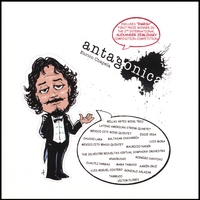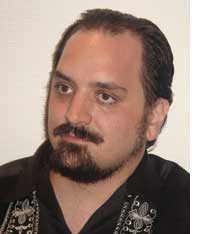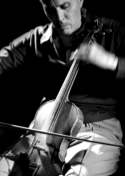Last night’s Green Umbrella concert of new music was the first concert in Los Angeles solely comprising Australian music, and it was a real success. As the second part of the Phil’s recognition of Dean as composer, he was given freedom to select the program and his own role. So we saw Brett Dean as composer, as performer on viola, as conductor, as commentator, as programmer, and — in all of these — as effective communicator. This was an evening that deserved to be recorded and made available for download so that more than the thousand in Disney Hall last night could hear this music and those performances. Dean, himself, is poorly represented on recordings. I find several including Dean as performer on viola, but only three containing a short composition each. To add to the pain, the most recent of these was a commission from the Berlin which is included on Rattle’s new release of Holst’s “Planets; the work, “Komarov’s Fall”, is on the recording — but Dean is not identified as composer so that an Amazon search on Dean will fail to find the work, and an iTunes search will locate the recording but fail to tell you which “song” is the reason for the match.
The major works of the evening were Dean’s. In the first half we heard his “Voices of Angels” (written in 1996, the oldest work on the program, as Dean pointed out). He wrote the work while still in Berlin, premiered by Berlin colleagues in the small hall of the Philharmonie. This work is for Schubert’s quintet: violin, viola, cello, bass, piano; by coincidence we heard the “Trout” on Monday night, and “Voices of Angels” (of similar length) could hold its own on a program including both, a program intended for less adventurous ears. I suppose the caveat is that the players must be good enough to handle the advanced techniques asked of them by Dean.
The climax of the second half of the concert was Dean’s “Pastoral Symphony” (2000), written on his return from Berlin to Australia and his rediscovery of Australian spaces and natural resources, specifically including its birds. Also impacting the piece was his recognition of the loss of environment from expansion and modernization; in the music a bucolic environment at the start of the work becomes largely supplanted by construction, by shopping centers, by freeways. The work is a 20-minute movement for a small chamber orchestra with prominent winds and percussion: 3 violins, 3 violas, 2 cellos, bass; flute, oboe, 2 clarinets, bassoon, 2 horns, 2 trumpets, trombone, tuba; 2 percussion, piano; sampler. I joined what seemed to be almost all of the audience in liking this work very, very much; however, as Dean told the audience, by a large margin this was the largest audience for a new music concert he had experienced — and the most responsive. We liked it. Salonen was just a few seats away; he like it, too.
The program began with the first U.S. performance of Liza Lim’s “Songs Found in Dream” (2005), commissioned by the Salzberg Festival and premiered by Klangforum Wien. Lim received a Phil commission, writing “Ecstatic Architecture” for the first season in Disney Hall. I wasn’t enthusiastic then, and the newer work last night didn’t communicate to me. My wife says the problem is with me; she said that the work clearly evoked the images in aboriginal art and in petroglyphs, and she was surprised I didn’t hear this. Lim’s web site includes music of three of her compositions.
For the second half of the program Dean introduced his younger (27) colleague, Anthony Pateras, who came on stage looking as if he’d much rather be in a club or a studio, and not in this large auditorium with audience sitting in orderly rows. (His web site gives a clue of why he might feel that.) He seemed much more relaxed when he returned on stage to acknowledge the continuing applause after his first work; later, after performing the second of two pieces, you could see him having his own “Sally Fields” moment: “They like me, they really like me!” I hope someone was taping this for his records, a few years from now.
The first Pateras piece was “Chromatophore” (2003) for amplified strings (2 of each instrument). The name comes from the pigment cell used to change colors by chameleons or fish. Through technique and amplification the work uses strings almost as percussion instruments; sustained tones (i.e., traditional string sounds) are minimized. The work was developed through improvizations, and while it now has a written structure, each player has cells in which independent playing is required. Within the approach of limiting sustained notes, the work explores the pitches of thee common diatonic scale. The music was challenging and stimulating.
Pateras’ solo work was a movement from a work-in-progress, “Continuums & Chasms, Movement vii”. This is for fully-prepared piano, in which each note of the piano is altered. For this work, Pateras seemed to structure the alterations into clusters: in some, sounding of a pitch was minimized; in others, the pitch and tonal color were altered in various ways, producing gong-like effects, for example. He uses very rapid fingerings as he moves across the keyboard, and the uses of different types of sound creates very interesting colorings. Both Pateras works were performed in U.S. premieres. I lack the language to convey how interesting these pieces were as music, not merely as sound.
The re-birth of Monday Evening Concerts is achieved! The brochure for the 2006-2007 season has been released and is shown on the web site. Four concerts! I only wish that at least one of the four concerts was for local new music and that another was for other American new music. My private campaign is for them to hire Kyle Gann as one of the curators. Well, maybe next year. Just having the program alive is accomplishment enough for now.
 Received a blurb from the LA Phil the other day, which in all caps proudly declares “LA PHIL LAUNCHES MICROSITE CELEBRATING INCOMING MUSIC DIRECTOR GUSTAVO DUDAMEL” … Kaboom!… Here’s the relevant bit (my bolds):
Received a blurb from the LA Phil the other day, which in all caps proudly declares “LA PHIL LAUNCHES MICROSITE CELEBRATING INCOMING MUSIC DIRECTOR GUSTAVO DUDAMEL” … Kaboom!… Here’s the relevant bit (my bolds):
 This is an exciting time for Chapela. He’s playing the guitar part in the premiere. Simultaneously, he’s working hard to finish a commission for the LA Philharmonic. “At first, I thought it would be too much to be the solo guitarist at the Brooklyn Philharmonic performances while trying to finish the piece for LA. But then I realized, who could ask for a better gig than this? Between practicing and writing, I told my wife to not expect to see me much for a couple of months!”
This is an exciting time for Chapela. He’s playing the guitar part in the premiere. Simultaneously, he’s working hard to finish a commission for the LA Philharmonic. “At first, I thought it would be too much to be the solo guitarist at the Brooklyn Philharmonic performances while trying to finish the piece for LA. But then I realized, who could ask for a better gig than this? Between practicing and writing, I told my wife to not expect to see me much for a couple of months!”
 The Los Angeles Master Chorale gave the premiere of a new work by
The Los Angeles Master Chorale gave the premiere of a new work by  The International Society of Bassists wanted a new concerto for their favorite instrument, and they wanted orchestras to play the work rather than merely filing its name in the list of new works that they might think about some future year. With help of their members they formed a consortium of 15 orchestras to back the work, enabling each participating orchestra to list themselves as a co-commissioner, giving each a “premiere” (even if merely a local one) at a bargain price.
The International Society of Bassists wanted a new concerto for their favorite instrument, and they wanted orchestras to play the work rather than merely filing its name in the list of new works that they might think about some future year. With help of their members they formed a consortium of 15 orchestras to back the work, enabling each participating orchestra to list themselves as a co-commissioner, giving each a “premiere” (even if merely a local one) at a bargain price. “What to Wear” ended its all-too-short run yesterday. When you find out its schedule for performance in New York, get your tickets right away. Better yet, get tickets for two dates (or more), because you’ll want more than one evening. As reported and commented on last week, this is the opera with music by
“What to Wear” ended its all-too-short run yesterday. When you find out its schedule for performance in New York, get your tickets right away. Better yet, get tickets for two dates (or more), because you’ll want more than one evening. As reported and commented on last week, this is the opera with music by